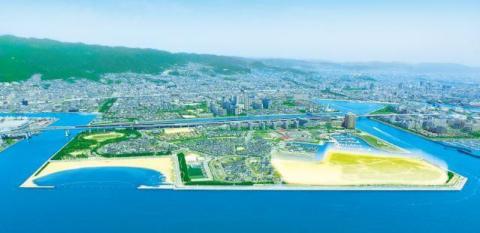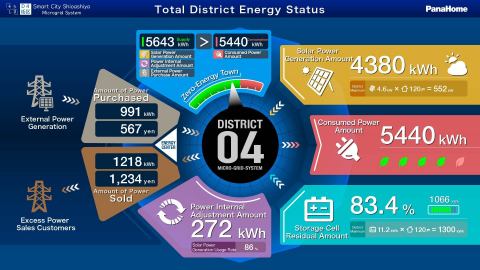HYOGO, Japan--(BUSINESS WIRE)--PanaHome Corporation, ENERES Co., Ltd, IBJ Leasing Co., Ltd. and the Public Enterprises Agency of the Hyogo Prefectural Government plan to embark on the urban development of a microgrid system (a regional energy distribution management system) (*1) starting October 2017.
[Video]
Launch of Japan's First Microgrid System with a Total of 117 Homes -
Smart City Shioashiya
https://www.youtube.com/watch?v=8Br0QgUxvK4
The microgrid system will power a total of 117 homes in Zone D4 of Smart City Shioashiya Solar-Shima, which is being designed and developed by PanaHome in Ashiya City, Hyogo Prefecture. On August 9, 2017, the project was selected as a part of the Ministry of Economy, Trade and Industry's subsidy program to promote local energy production for local consumption by leveraging regional characteristics.
This is a joint project being carried out by PanaHome, ENERES, IBJ Leasing and the Public Enterprises Agency. The project concept is a "town interconnected by energy for living." PanaHome purchased land that was developed by the Public Enterprises Agency. Panasonic Corporation and the City of Ashiya are also cooperating with the development of this project. A part of the project entails building Japan's first (*2) microgrid system. Solar energy will be used to power 80% or more (*3) of the entire housing district. This will be made feasible by running private power distribution lines (*4) to the housing district and sharing power between homes. Even when the district becomes disconnected from the traditional electrical grid during emergencies, the private power distribution lines can continue to supply power via specific circuits. Private power distribution lines make it possible to receive power and flexibly set power rates. Consequently, this poses a number of benefits for homeowners including, a 20% cut in their electricity bill. Another key goal is to contribute to the environment, mainly by maximizing use of renewable energy to reduce CO2 emissions. Going forward this project will contribute to solutions for sharing electric power between buildings, preventing blackouts in areas overseas where power grids are weak, and in showcasing these solutions overseas.
[Responsibilities of each project participant]
Applicants
- PanaHome
(Main applicant)
Design, development, housing construction, and
overall planning of the smart city
- ENERES
(Joint applicant)
Energy management services
- IBJ
Leasing (Joint applicant)
Own and manage private
power distribution lines
- Hyogo
Public Enterprises Agency (Joint applicant)
Residential
land development and regional cooperation
[Partners]
- City of Ashiya, Hyogo Prefecture
Regional collaboration
for urban development of Shioashiya
- Panasonic Corporation
Collaboration on power storage
management systems, technical support, and the safety and management of
private power distribution lines
[Background]
In the wake of the Great East Japan earthquake, demand emerged for the introduction of distributed energy systems highly resilient to disasters. The quake made it apparent that centralized energy systems were vulnerable to such disasters. Meanwhile, it has also become necessary to flexibly offset the unstable supply of electric power with a considerable expansion in the use of renewable energy. In addition, there is a need to shift from the wider use of solar power via the feed-in tariff (FIT) scheme, to the expanded use of solar power sources via the effective use of local energy production for local consumption.
Since 1998, Hyogo Prefecture and the City of Ashiya have been carrying out development in the Shioashiya area, which is in the Minami Ashiya-hama district, based on the concept of urban development that connects people. From 2012, PanaHome embarked on the development of Smart City Shioashiya Solar-Shima, which is comprised of roughly 400 individual homes and 3 condominium complexes (total of 83 condos). The company's highly energy-efficient buildings and its large-scale urban development which maximizes the use of renewable energy has won the company high praise, even from overseas. The company recently won a Gold Award in the "Smart Buildings" category of the 3rd APEC (Asia Pacific Economic Cooperation) ESCI (*5) Best Practice Awards.
[Overview of the microgrid system and the specified supply (*6) scheme]
A solar power generator (4.6kW), storage cell (11.2kWh) and HEMS (*7) has been installed in each of the homes in this project. Within the housing district, each home's storage cell is connected by private power distribution lines. The storage cell control unit makes it possible to reverse the power flow current and mutually share electric power between homes. This is the first such microgrid system (regional energy distribution system) in Japan.
Specified supply scheme using private power distribution lines
The management association consists of homeowners of the 117 homes in the residential district. The management association has outsourced the power storage cell control management to ENERES, a company with expertise in this area. Based on a specified supply scheme to control the supply of power from storage cells to association members (residents), it will be possible to operate an EMS (*8) system and provide power coverage to the entire district by employing IBJ Leasing's environmental solutions, which were derived from its financial knowhow, to introduce private power distribution lines.
- Business location: Smart City Shioashiya Zone D4
- Site:
Suzukaze-cho, Ashiya, Hyogo, Japan
- Coverage: Smart City
Shioashiya Zone D4
- Main renewable energy: Roughly 32,007.92 m2
-
Shared energy: Electric power
- Start of operations: October 2018
[Features of the microgrid system]
1. Low power rates and free power control owing to the use of private
power distribution lines
The use of private power distribution
lines makes it possible to freely control the receipt of electric power
and storage cells in the housing district and to flexibly set power
rates. Furthermore, it will be possible to reduce power rates by 20% by
improving the rate of self-sufficiency on renewable energy by sharing
power between homes.
2. Equalize supply-demand balance for electric power in the district
via regional control of storage cells
Peak demand for power
will be controlled within the area through the regional control of
storage cells connected by the private power distribution lines. By
entering into contracts for receiving power with new power companies
(hereinafter referred to as a PPS (*9)), when it is expected that the
area will exceed its contracted power supply, the system orders a
discharge of electric power to equalize the supply of electric power.
3. Continued power supply even if supply from main grid is suspended
(designated circuit)
During normal energy usage, the entire
district will maximize use of solar power. When there is shortage of
electric power, renewable energy will be supplied over the PPS grid (FIT
power source (*10)) to maintain a stable power supply. During an
emergency where the main power grid is interrupted, it is possible to
continue to supply power to homes in the district by supplying power to
designated circuits (refrigerators, lighting, cell phone rechargers,
etc.) from power storage in storage cells or solar power generated
within the district.
[Overview of shared power among homes in the district]
In this project, all homes are equipped with solar power generators, storage cells, and HEMS. The storage cells installed in each home are connected to form a network. The power stored in the storage cells (11.2kWh) can be shared by the 117 homes in the district. It is as if there is a giant storage cell with 1.3MWh of power. Homes with surplus electricity can share with homes that have a shortage of power. This reduces the need to purchase energy from external sources and maximizes the use of solar power generated within the district.
[Expected benefits]
1. Self-sufficiency rate of 80% or higher owing to the local production and local consumption of solar power (environmental benefit)
2. A 20% reduction in electric power rates owing to receipt of power and storage cell control (economic benefit)
3. 100% use of renewable energy (solar power generated in the district and FIT source outside the housing district) (environmental benefit)
4. Possible to supply power even when power supply from the main grid has been interrupted (designated circuits) (dealing with disasters)
5. Equalize power supply within the district (social benefit)
[Hybrid deployment of microgrid VPP (*11) feasibility test]
In addition to the deployment of a microgrid, a feasibility test will be conducted for the VPP control unit. When instructions, including demand response (*12) orders from the resource aggregator (*13), come from above, the goal is to control the inflow and outflow of power from storage cells in each home to address the increase or decrease of power consumption in the district, as if it were all functions as one power generator.
Notes:
*1. A small-scale power grid. A small power generator
facility, including solar power generator, is set up in an area to
supplement power demand using a local production, local consumption
model.
*2. It is Japan's first point that makes to share electric
power mutually at 117 homes by running private distribution lines in the
housing district.
*3. (Amount of solar power consumed privately +
amount of surplus power shared) ÷ Total power consumption (Annual basis;
based on a simulation performed by PanaHome)
*4. Power distribution
lines privately installed to supply power without relying on general
power distribution companies.
*5. Energy Smart Communities
Initiative (ESCI): Network launched in 2010 at the Yokohama APEC
meeting. APEC member countries and regions collaborate on projects in
five fields - smart buildings, smart grid, low-carbon model town, smart
job and consumer, and smart transport - through the introduction of new
technologies.
*6. Article 17 of the Electric Business Act
(Specified Supply): System whereby an electric power supplier that meets
certain criteria obtains a license for each location to which they plan
to supply power and supplies power to that specific target.
*7.
Home Energy Management System (HEMS): Energy usage is not only made
transparent but also optimally controls electric use of consumer
electronics and electrical facilities installed in the home.
*8.
Energy Management System (EMS): Monitors and controls energy via a
network, including making energy usage, including electric power usage,
transparent, and optimally manages facilities.
*9. Power Producer
and Supplier (PPS): Designated scale power products, generally known as
new power suppliers. A company that obtains a license and newly enters
the electric power industry.
*10. Electric power using a Feed-in
Tariff (FIT) source (system whereby the purchase price of renewable
energy is decided by law)
*11. Virtual Power Plant Response (VPP):
Network or system that centrally controls a number of small solar power
or other generators as if it were one large power generator.
*12. A
resource aggregator collects energy resources from consumers for energy
producers (power transmission and distribution companies, retail
electric power companies, and renewable energy power producers).
*13.
Demand Response: Transform power consumption patterns by curbing
consumer power usage through incentives or by setting higher rates
during times when market prices are skyrocketing or when the reliability
of the grid is weak, such as when supply and demand for electric power
are strapped.
Source: http://news.panasonic.com/global/topics/2017/50883.html
Related Links
[Video] Launch of Japan's First Microgrid System with a Total of 117
Homes - Smart City Shioashiya
https://www.youtube.com/watch?v=8Br0QgUxvK4
Smart City Shioashiya "Solar-Shima" website (Japanese)
http://city.panahome.jp/sorashima/index.php?frm=shioashiya
PanaHome Global
http://www.panahome.jp/english/
HEMS (Home Energy Management System) | Industrial Devices & Solutions
https://industrial.panasonic.com/ww/applications/ha/hems
ENERES Co., Ltd. (Japanese)
https://www.eneres.co.jp/
IBJ Leasing Co., Ltd.
https://www.ibjl.co.jp/en/index.html
Hyogo Prefecture
https://web.pref.hyogo.lg.jp/fl/index.html





